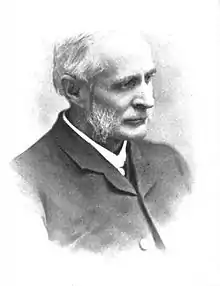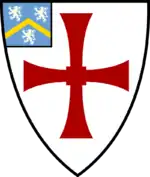Hatfield College, Durham
Hatfield College is one of the constituent colleges of Durham University in England. Founded in 1846 as Bishop Hatfield's Hall by former Oxford don David Melville, it was the second college to be associated with the university, after University College (1832).[2]
| Hatfield College | ||||||||||||||||||||||
|---|---|---|---|---|---|---|---|---|---|---|---|---|---|---|---|---|---|---|---|---|---|---|
| Durham | ||||||||||||||||||||||
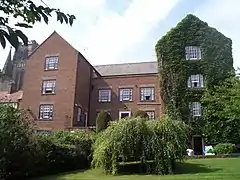 | ||||||||||||||||||||||
 Arms of Hatfield College Arms: Azure a Chevron Or between three Lions rampant Argent a Bordure Ermine | ||||||||||||||||||||||
| Location | North Bailey, Durham, DH1 3RQ | |||||||||||||||||||||
| Coordinates | 54.7744°N 1.5741°W | |||||||||||||||||||||
| Motto | Latin: Vel Primus Vel Cum Primis | |||||||||||||||||||||
| Motto in English | Either the first or with the first | |||||||||||||||||||||
| Established | 1846 | |||||||||||||||||||||
| Named for | Thomas Hatfield | |||||||||||||||||||||
| Master | Ann MacLarnon (2017–) | |||||||||||||||||||||
| Undergraduates | 1010 (2017/18)[1] | |||||||||||||||||||||
| Postgraduates | 260 (2017/18)[1] | |||||||||||||||||||||
| Website | dur | |||||||||||||||||||||
| Map | ||||||||||||||||||||||
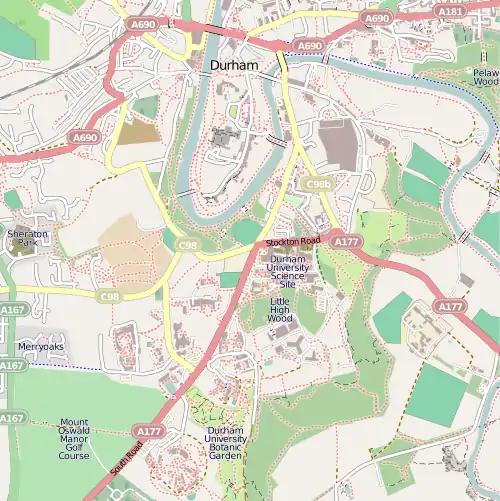 Location in Durham, England | ||||||||||||||||||||||
Taking its name from Prince-Bishop Thomas Hatfield, the college pioneered the concept of catered residences for students – a practise later introduced at Keble College, Oxford and eventually worldwide.
After many decades as a single-sex institution, the first female undergraduates were formally admitted in Michaelmas term 1988.[3]
Hatfield occupies a large site above the River Wear on North Bailey and close to Durham Cathedral on the World Heritage Site peninsula. The buildings are an eclectic blend of 17th-century halls, early Victorian buildings and major additions during the last century. A£5 million refurbishment to the Jevons building, including the bar and student accommodation, was unveiled in October 2018.[4]
The master of the college is Ann MacLarnon, Professor of Evolutionary Anthropology at Durham University.[5]
History
Early years
The establishment of the college in 1846 as a furnished and catered residence with set fees was then a revolutionary idea, but later became general practice at student residences. This concept came from the young founding master, David Melville, who believed it would make a university education more affordable. Three principles of the model were that rooms would be furnished and let out to students with shared servants, meals would be provided and eaten in the college hall, and college battels (bills) were set in advance.[6] This system made Hatfield a more economical choice when compared to University College, ensuring that student numbers at Hatfield built up steadily.[7] Melville's model was introduced to the wider university after an endorsement from the Royal Commission of 1862.[7]
Although not intended as a theological college, for the first 50 years the majority of students tended towards theology, while senior staff members and the principal were in holy orders. Under William Sanday (1876–1883) student numbers rose considerably, prompting a desperate search for extra rooms. It was forced to rent 3 South Bailey (now part of St John's College) in 1879 to accommodate them.[8] Though Hatfield was run on the most economical lines student poverty was a frequent problem. Dr Joseph Fowler, who, apart from his roles as Chaplain and Senior Tutor in the college, acted as Bursar, allowed undergraduates to take on some debt and even loaned them money, often employing rather creative accounting practises in the process.[8] In 1880 a tennis court was installed for the first time, occupying roughly the same space as the current one.[8] In the 1890s the college purchased Bailey House and the Rectory (despite its name, most previous occupants were laymen) to accommodate more students.[9] As the end of the century drew closer the balance of undergraduate students rapidly shifted away from theology. In 1900, there were 49 arts students who had matriculated within the previous 3 years, and 20 in theology.[10] By 1904 just 9 theology undergraduates are recorded, compared to 57 in arts.[11]
Inter-war
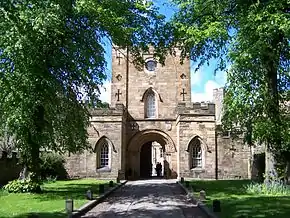
The inter-war period saw a decline in college fortunes. In the first two decades of the 20th century Hatfield had experienced a sharp fall in numbers. This was caused initially by the decision to isolate science courses at the campus in Newcastle, an increased tendency to train priests at specialised colleges, poor finances, and finally the outbreak of the First World War.[12] For 15 years after 1897, total students in residence numbered above 100.[12] This had fallen to 69 in 1916, 2 in 1917, and to 3 in 1918.[12] After the war finished there was a temporary leap to more than 60 undergraduates, but by 1923 there were just 14 men on the college books.[12] In 1924 a new science department was established in Durham, and this, along with the active recruiting efforts of new Master Arthur Robinson (1923–1940), achieved gains in student numbers.[13] Within five years of Robinson's appointment they had quintupled from the low of 1923.[14]
But the economic crisis of the 1920s created uncertainty. Hatfield had more students than University College yet lacked the facilities, especially kitchens, to accommodate them. University College, on the other hand, was comparatively undersubscribed. To address this, the two colleges effectively amalgamated under the guidance of Angus Macfarlane-Grieve, and all meals were taken together in the Great Hall of University College, while each college retained its own set of officers and clubs.[9] Unhappy with this arrangement, some Hatfielders expressed their separate identity in trivial ways: for example, using a different door to enter the Castle dining hall than the University College students, and, in contrast to the University College contingent – turning to face the High Table during grace.[15]
The political situation in Europe impacted college activities: during one memorable rag week in 1936, Hatfield students staged a mock Nazi procession to the nearby Market Square, with participants dressing in jackboots, brown shirts, and fascist armbands.[16] One of them, Joe Crouch, a fluent German speaker, comically impersonated Adolf Hitler and delivered an impromptu speech to the assembled crowd.[16] In 1938, fears of an impending war resulted in the construction of an air raid shelter, with dons and servants digging trenches in the Master's garden (now Dunham Court).[16] Gas masks were issued to college residents.[16] Meanwhile, a recent decline in the number of freshers, and the death that year of John Hall How, the Master of University College, gave rise to rumours that Hatfield would be annexed to its older neighbour.[16]
World War II
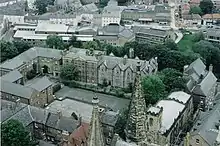
In October 1939 Hatfielders suffered the misfortune to be barred from their own college when the university decided to use Hatfield as a temporary site for the new Neville's Cross College, an institution for training women teachers. Having spent over a decade taking meals in Castle, they would now be prevented from using Hatfield buildings altogether.[16] Without its own buildings and Master, and the issue of the ongoing war, Hatfield was in a poor position to recruit new students, an era later described as the 'wilderness years' by college archivist Arthur Moyes.[17]
However, the college received an unexpected new lease of life when the Royal Air Force established short courses at the university for some of its cadets, and soon these cadets made up half of the Hatfield student body. This led the university to postpone plans to merge Hatfield with University College.[18] Plans were revived again in 1943, but met the strong opposition of Hatfield dons, especially Hedley Sparks.[19] In 1946, the centenary year of the college, members formed the Hatfield Association to both represent alumni and demonstrate to the university council that Hatfield was supported.[19]
Post-war
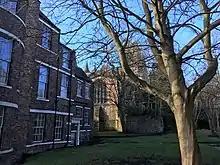
The university finally decided that from October 1949 Hatfield would be reestablished as an independent college – with Vindolanda archaeologist Eric Birley (1949–1956) appointed to serve as the new Master.[20] The post-war period saw Hatfield once again faced with the familiar problem of squeezing in a larger student population, as the war had created a growing backlog. More buildings were constructed and refurbished.[21] Moreover, accommodation was acquired away from the main site and the Senior Common Room was established. In 1962 it was decided that a brass plaque should be fixed to the college gates identifying the establishment as Hatfield College.[22] Just 24 hours after installation a group of students from a rival Bailey college were caught trying to remove the plaque as a sporting trophy.[23] In 1963 the college received its first taste of student protest, when a "militant minority group of young gentlemen united under the banner of International Socialism".[24] Around the same time students voted to boycott formal dinners after a row with Master Thomas Whitworth (1957–1979) over whether or not jeans counted as formal wear.[25]
Reforms were subsequently introduced. Joint standing committees, composed equally of staff and students, were set up to "deliberate almost every conceivable topic" and the undergraduate Senior Man was allowed to take part in meetings of the college's governing body.[24] By 1971 a 'liberal and balanced' Governing Body had been achieved: consisting of 4 college tutors, 4 elected tutors, 4 delegates from the Junior Common Room, and a representative from the Hatfield Association alumni group.[24] Writing in the same year, a satisfied Whitworth was able to boast of warding off the 'mischievous opportunism' of student 'exhibitionists'.[26]
Modern
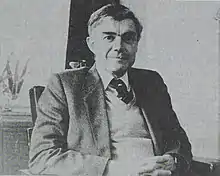
The leadership of James Barber (1980–1996) was a period of significant change. Student numbers rose significantly, increasing to over 650 by the time he finished his tenure in office.[9] Living out became compulsory for students for at least part of their career, and many of the existing buildings were either rebuilt or refurbished to make room for students: The Rectory was remodeled, C & D Stairs were refurbished, the Main Hall was repaired, and Jevons' was redecorated.[9] A Middle Common Room for the postgraduate community was added in Kitchen Stairs. In 1981, it was decided the Formal Ball would be renamed 'The Lion in Winter', which it has been called ever since.[27] More comically, 'C Scales', a goldfish, was elected as a member of the JCR in 1982 and put forward as a potential Durham Student Union President.[27] In 1984, the JCR was sued by representatives of the band Mud after a student ruined four speakers by pouring beer into an amplifier during a performance at a college ball.[28]
Hatfield also became co-educational, which at the time was only 'grudgingly accepted' by the college.[9] In 1985 talk of going mixed was stimulated by the low numbers of applicants selecting Hatfield as their preference, and a recent decline in academic standards – with the college finishing bottom of the results table the previous year.[29] Despite threats of hooliganism, the Senior Common Room decided in May of that year to push forward with plans to go mixed.[30] In March 1987 a student referendum was held on the issue, with 79.2% voting for the college to remain men only.[31] The Senate decided that, despite the referendum result, the college would in fact go mixed the following year.[31] The first female Senior Man held the post in 1992.[9] Her election win, by a single vote, prompted some students to declare a week of mourning and walk around the college wearing black arm bands.[31]
Buildings
Main Court
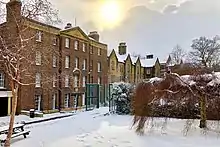
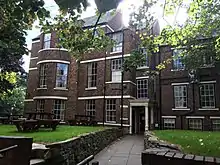
The oldest part of the college site is what is today the dining room, which probably dates back to the 17th century.[32] In the 18th century the building became a coaching inn, The Red Lion – a stopping point for coaches travelling between London and Edinburgh. During this time it was also used to host concerts, likely featuring the work of composers like Charles Avison and John Garth.[33] In 1845 the Red Lion building was put up for sale, allowing it to become the first component of Hatfield College the following year.[32] The C and D accommodation blocks are now located here.[34] D Staircase formerly had a reputation for being haunted by a female spirit, recognisable by the aroma of a distinctive perfume.[35] At the west end of the dining room is Kitchen Block, which features the main kitchens as well as a small number of student rooms and offices on the higher floors.[21]
The building that contains A and B accommodation blocks, and once known as 'A and B Stairs', was renamed and rededicated as the Melville Building in 2005 after a £1million refurbishment.[36] Author Josceline Dimbleby, the great-great-granddaughter of David Melville, was invited to perform the ceremony.[37] Next door to the Melville Building is C Stairs. Officially opened in 1932 by Lord Halifax, it replaced an earlier section of the coaching inn used since the founding of the college.[21] Moving south, visitors will soon reach the Rectory. Acquired in 1897, this is the administrative hub of the college, encompassing as it does the offices of the Master, the Vice-Master & Senior Tutor, the Assistant Senior Tutor, the Chaplain, the Senior Administrative Secretary, the Senior Tutor's Secretary, the Finance Officer and the Hatfield Trust/Association.[34] The Birley Room, used for social functions, can be found at the ground floor of the Rectory.[34] Added to the college at the same time as the Rectory, Hatfield Cottage is in between the redundant church of St Mary-le-Bow (now the Durham Museum and Heritage Centre) and Gatehouse Block. It is where the Middle Common Room (MCR) is now located, having moved from its former space in Kitchen Block.[34]
Gatehouse Block is to the right of the entrance and houses the porters' lodge. It also has single and twin use student rooms.[34] In 1961 the college had begun a project to replace the remnants of a much older gatehouse that was in poor condition. The new pseudo-Georgian replacement was completed by Easter 1962 for a total cost of £55,000.[22] To provide an unbroken front to the North Bailey, decorative gates and railings were installed in the aftermath.[22]
Dunham Court
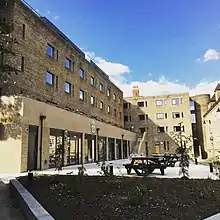
Named after alumnus Kingsley Dunham, Dunham Court is the second quadrangle of the college. It is accessed through an underpass by the chapel, and comprises two buildings, Jevons (Frank Jevons) and Pace (Edward Pace). An influx of extra students after the war stimulated a demand for more accommodation and the garden of the old Jevon's House provided the available space. The new building, described by Pevsner as 'friendly', with a 'nice rhythm of windows towards the river', was finished in 1950 and named after former Vice-Master Edward Pace.[38]
The college commenced the largest building project in its history when it demolished the old Jevon's House, a decrepit structure once occupied by the bare-knuckle boxer John Gully before being purchased by the university.[39][40] Construction of the new modernist style Jevons Building, which would complete the new Dunham Court, began in June 1966. It was officially unveiled in a ceremony in June 1968 attended by both Kingsley Dunham and Lord Lieutenant of Durham James Duff.[41] It won a Civic Trust Award the following year.[41] Both buildings contain rooms and social spaces: the college bar and cafe is located in Jevons, while Pace has a TV lounge, a music room, two gyms, and the JCR Common Room.[42]
Chapel
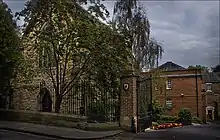
The college chapel, at the left of the main college gates, was conceived in 1851 and built by 1854, funded by donations by alumni and a loan of £150 from the university.[9] It was designed by then chaplain to Bishop Cosin's Hall, James Turner (also a trained architect), and contains two head sculptures of William Van Mildert and Warden Thorp. Decorative furnishings were later added and the first organ was installed in 1882. Commemorative wooden panels marking the First World War dead and a book of remembrance for them, along with a lectern, were added gradually and were primarily funded by alumni and the Hatfield Association. The chapel houses a Harrison & Harrison organ, which is used to accompany services and for recitals. In 2001 it was refurbished at the cost of £65,000.[9]
Attendance at chapel services was compulsory for 80 years after the foundation of the chapel until the onset of World War II ended the compulsory attendance to Cathedral services. Since then the chapel constitutes an 'important but minority interest' in the college.[9]
Services are led by the college chaplain, currently Anthony Bash. The College Chapel Choir is led by a student choral director, supported by an organ scholar and deputy organ scholar. The Chapel Choir consists mainly of students who support regular worship in the chapel, but also sing at churches and cathedrals throughout the country and undertake annual tours both at home and abroad.[43]
Other buildings
Opposite the gatehouse on North Bailey is Bailey House, an accommodation block which provides 50 single rooms, plus a communal and kitchen area on the ground floor.[34] Palmers Garth is approximately a minute away from the main site of the college, and can be found by going down Bow Lane and across the Kingsgate Bridge over the River Wear. Opposite Dunelm House, it offers 8 twin and 41 single rooms for 57 students.[21] The building was formerly used for administration by the university, and once hosted the careers service until it was handed over to Hatfield College in 1991.[21]
The postgraduate accommodation site is James Barber House, or JBH for short, a self-catered residence on Church Street that is close to the science site of the university and the Bill Bryson Library. Now named after former Master James Barber, it was completed by Durham County Council as Palatine House in 1968, and originally a care home for the elderly before its purchase by the college in 2006.[21]
College traditions
Arms
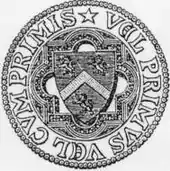
From its foundation, the college used as its arms the personal shield of Thomas Hatfield (Azure, a chevron or, between three lions rampant argent).[44] This was accompanied with the Latin motto "Vel Primus Vel Cum Primis", which literally means "Either First or With the First",[45] though is now loosely interpreted by the college as "Be the Best you can Be".[46]
In 1954, the college was informed that the use of Bishop Hatfield's shield without registration with the College of Arms was inappropriate,[47][45] and it sought a grant of its own from the College of Arms. The new arms were based on Hatfield's shield, but with an ermine border added to difference the college's arms from the bishop's, resulting in an overall shield blazoned Azure a Chevron Or between three Lions rampant Argent a Bordure Ermine. The grant also included the motto "Vel Primus Vel Cum Primis", and a crest described as Out of an ancient crown Or a panache of five ostrich feathers ermine charged with a chevron sable.[48]
Academic dress
Similar to most Bailey Colleges the wearing of the undergraduate academic gown is required to formal events. The wearing of the gown is at the discretion of the Master of the college and at present is worn at Matriculation, in chapel and at formal meals held in the hall twice per week.
Grace
Benedicte Deus, qui pascis nos a iuventute nostra et praebes cibum omni carni, reple gaudio et laetitia corda nostra, ut nos, quod satis est habentes, abundemus in omne opus bonum. Per Jesum Christum, Dominum Nostrum, cui tecum et Spiritu Sancto, sit omnis honor, laus et imperium in saecula saeculorum. Amen.
This can be translated as: Blessed God, who feedest us from our youth, and providest food for all flesh, fill our hearts with joy and gladness, that we, having enough to satisfy us, may abound in every good work, through Jesus Christ our Lord, to whom with thee and the Holy Spirit, be all honour and praise and power for all ages. Amen.
The grace was widely used in the fourth century and is based on earlier Hebrew prayers. It was translated from the Greek and adopted by Oriel College, Oxford. Presumably influenced by Henry Jenkyns, who was a Fellow of Oriel, Hatfield adopted this grace practically verbatim. Since 1846 the grace has been read at all formal meals in College which occur once a week, or twice in Michaelmas Term.
Student body
As of the 2017/18 academic year, Hatfield College has a population of 1,339 students.[1] There are 1,007 full-time undergraduates and 3 part-time undergraduates.[1] Postgraduate figures include 55 students on full-time postgraduate research programs and 111 studying for full-time postgraduate taught programs, plus a further 94 part-time postgraduate students (research and taught) as well as 69 distance learning students.[1] Student numbers have grown significantly since the 2003/04 academic year, when the college comprised a total of 779 students.[49]
Formals
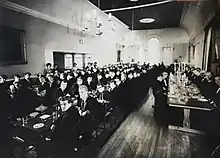
Formals take place twice a week on a Tuesday and Friday in Michaelmas Term, reducing to Fridays only for the rest of the academic year. There are a number of traditions at Formals. Students are required to wear their full academic dress including gowns for formal dinners except when it is a black or white tie event. A High Table consisting of members of the SCR and guests is present at every formal, with the Master's entrance and "bowing out" signifying the official opening and closing of the formal meal.
Unique to Hatfield is the tradition of 'spooning', in which students bang spoons on the edge of the table or on silverware for several minutes before the formal starts.[50] The act immediately ceases when the High Table walks in.[50]
Common rooms
The student body is divided into three "common rooms". The Junior Common Room (JCR) is for undergraduates in the college. The JCR annually elects an executive committee consisting of 10 members including an impartial chair. The executive committee ensures the successful running of the JCR, in conjunction with the college officers.[51] Unlike other colleges, Hatfield exclusively retains "Senior Man" as its title for the head of the JCR, having rejected a motion to move to "JCR President" in May 2014[52] and again in June 2020 and January 2021. A motion to allow the incumbent to choose between "Senior Man", "Senior Woman" or "Senior Student" was also defeated in January 2016.[53]
The Middle Common Room (MCR) is the organisation for postgraduate students which also have an elected organising committee. Postgraduate accommodation is located at James Barber House.[54] College officers, fellows and tutors are members of the Senior Common Room (SCR).[55] Each common room acts as a separate body for its members, although collaboration between them is common, and it is possible to be a member of these organisations simultaneously.
Admissions
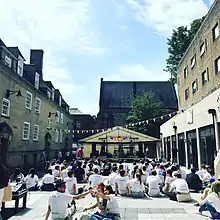
Hatfield tends to be one of the more popular colleges for applications. For the 2015/2016 entry cycle 1,375 applicants selected the college as their preference.[56] This made it the 5th most popular overall, behind University College, Josephine Butler College, Collingwood College, and St Mary's College.[56] 336 accepted applicants ultimately enrolled.[57] Compared to most other colleges, Hatfield receives a somewhat higher percentage of gap year applicants who choose to defer entry, with 7.8% of applicants in the 2015/2016 cycle choosing to defer, against a university average of 3.8%.[56] Figures for the two previous admissions cycles were 6.3%[58] and 6.4%[59] respectively. Overall, figures for 2016 entry show that of all offer-holding applicants who selected Hatfield as their college preference, 78% were successful in gaining a place at the college.[60]
Image
On campus the college has a longstanding reputation for being 'rah',[61][62] with one mocking student article calling it a 'moneyed, upper-class college equivalent of Millwall FC' and holding Hatfield responsible for perpetuating negative stereotypes about the wider university.[63] The college was described as being 'very public school' and 'cliquey' in a 2012 university guide that appeared in society magazine Tatler.[64] In recent years the college has tried to address this reputation with an outreach programme working with pupils in local state schools in Gateshead, Hartlepool, and Washington.[65]
Admissions statistics do show it to be disproportionately popular with applicants from independent schools, typically enrolling a significantly higher percentage than other colleges. For the 2015/2016 cycle, 65.8% of applicants were privately educated – against a university total of 36.1%[66] – with 34.2% applying to Hatfield from state schools.[66] By comparison, the College of St Hild and St Bede was the second most popular with independent school applicants at 54.5%, with all other colleges receiving less than half of their applications from independent schools.[66] Hatfield's total represents a slight decrease from the previous application cycle, in which 67.6% of applicants were from independent schools.[67] This is still higher than many Oxbridge Colleges[68]
College officers and fellows
Master
The current master is Ann MacLarnon, having assumed the role in September 2017.
List of past masters
- David Melville (1846–1851)
- William Henderson (1851–1852)
- Edward Bradby (Michaelmas Term 1852)
- James Lonsdale (1853–1854)
- John Pedder (1854–1859)
- James Barmby (1859–1876)
- William Sanday (1876–1883)
- Archibald Robertson (1883–1897)
- Frank Jevons (1896–1923)[69]
- Arthur Robinson (1923–1940)[70]
- Angus Macfarlane-Grieve (1940–1949) as acting Master[71]
- Eric Birley (1949–1956)[72]
- Thomas Whitworth (1957–1979)[73]
- James Barber (1980–1996)[74]
- Tim Burt (1996–2017)[75]
Fellows
Hatfield College Council awards honorary fellowships on the advice of the master to alumni and people who have a close association with Hatfield. On receipt of the fellowship the fellow automatically becomes an honorary member of the SCR and receives the same benefits. As of 2012, honorary fellows numbered 24 in total, notably including former university chancellor Bill Bryson.[76]
Other staff affiliated to the college include eight junior research fellows[77] and 10 Senior Research Fellows.[78] Current senior fellows include, amongst others, the theologian Douglas Davies.[78] The college also occasionally hosts visiting academics, normally for one term, as part of the fellowship scheme offered by the university's Institute of Advanced Study.[79]
Sports and societies
Hatfield College Boat Club
Hatfield College Boat Club (HCBC) is the boat club of Hatfield College at Durham University. The club was started in 1846, shortly after the founding of the college, making it one of the oldest student clubs in Durham.[80] There is a Novice Development programme for absolute beginners.[80] It also trains coxes and has a dedicated Coxes Captain.[80]
The current college boathouse was completed in Epiphany term of 1881, with the previous structure having to be rebuilt and re-sited at the cost of £250 – club members believing it to be 'inconveniently small' and very exposed to flood damage.[81] Up until 2001 Hatfield shared its boat club with rowers from Trevelyan College. Tension over space, resulting from Hatfield's desire to purchase additional boats, saw the termination of this arrangement, with Trevelyan later electing to store its boats with the local owner of a private boathouse.[82]
In 2016 the boathouse was one of several to fall victim to racist graffiti and had a swastika and SS symbol splashed on the doors.[83] Major maintenance was carried out in 2019: the roof was reinforced and the doors sanded and repainted.[84]
Notable former members of the club include Alice Freeman, Louisa Reeve, Angus Groom, and Simon Barr.
Rugby
Hatfield College has become known for prowess in rugby in particular, with the college coming to be regarded as a nursery for British rugby – so much so that Thomas Whitworth (Master, 1957–79), a known rugby enthusiast, was often accused of bias in the selection and treatment of rugby-playing students.[9] In intercollegiate rugby Hatfield became the dominant club in the decades following the war, conceding the colleges cup just once in a 14-year period up to 1971.[85] The Durham University team that triumphed in the 1969 University Athletic Union final against Newcastle University was made up mostly of Hatfield players.[86]
In recent years Hatfield, though still regarded as the traditional 'rugby college', has faced stiffer competition from other college sides, especially Hild Bede.[87] Today, double protein portions for university rugby players are still offered in the college dining hall each meal-time.[88]
Will Carling, Will Greenwood, and Marcus Rose are the most notable former undergraduates, with Richard Breakey, Jeremy Campbell-Lamerton, Charlie Hannaford, Andy Mullins, Dave Walder, Peter Warfield, and Ben Woods also claiming international caps.
Other sports and societies
In cricket, Andrew Strauss, winning captain during the 2009 Ashes, former Worcestershire captain Tim Curtis, ex-Middlesex batsman Nick Compton, and fast bowler Typhoon Tyson, the Wisden Leading Cricketer in the World for 1955, were all students of the college.
Hatfield also has its own theatre group, the Lion Theatre Company, which performs in Durham University's Assembly Rooms theatre located opposite the college gates, and a music society organising various ensembles. Students also produce the termly college magazine, The Hatfielder. It has SHAPED, which is a personal development program.[89]
Notable alumni
Hatfield alumni are active through organisations and events, such as the Hatfield association, which now has a membership of more than 4,000 graduates.[90] Former students of the college referenced below include sportsmen, politicians, military officers, diplomats, broadcasters and journalists, entertainers, scientists, and business people.[lower-alpha 1]
Some Hatfielders with more idiosyncratic career paths defy straightforward categorisation and are not listed in the below sections. They include: an academic and United Nations official who married a Princess, a security consultant with ties to a mercenary coup attempt in Africa, a financially profligate serial school founder, and a pioneering clergyman ecologist.
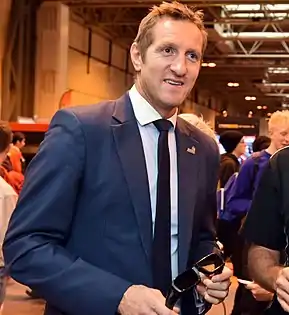 Will Greenwood, winner of the 2003 Rugby World Cup
Will Greenwood, winner of the 2003 Rugby World Cup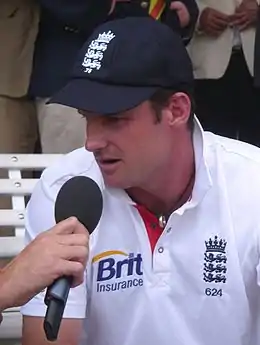 Andrew Strauss, English international cricketer
Andrew Strauss, English international cricketer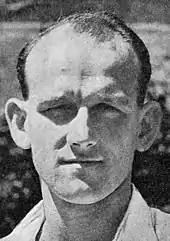 Frank Tyson, seen here in his heyday
Frank Tyson, seen here in his heyday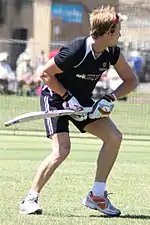 Nick Compton, Middlesex and England batsman
Nick Compton, Middlesex and England batsman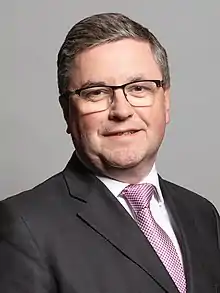
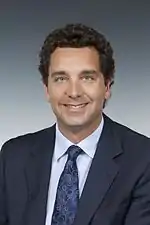 Edward Timpson, MP for Eddisbury
Edward Timpson, MP for Eddisbury Baron Carter of Coles, Life Peer
Baron Carter of Coles, Life Peer
The sporting alumni of Hatfield College may be the most famous, among them former England rugby union captain Will Carling,[99] 2003 Rugby World Cup winner Will Greenwood,[100] and former England cricket team captain Andrew Strauss.[101] Fast bowler Frank Tyson and top order batsman Nick Compton and Tim Curtis are three other cricketing former students who made test match appearances for England.[99][102][103] In rowing, Simon Barr, Alice Freeman, Angus Groom, Louisa Reeve, and Emily Taylor have all achieved success at international level. Athletes Jon Solly and Mark Hudspith medalled at the 1986 Commonwealth Games and 1994 Commonwealth Games respectively.[99] Katharine Ford remains the only Briton to ride an Indoor Velodrome for 12 hours or more.[104]
Politicians and campaigners who have attended the college include Robert Buckland, the current Secretary of State for Justice and Lord Chancellor; Edward Timpson, the MP for Crewe and Nantwich and former Minister of State for Children and Families; and Labour Party life peer Baron Carter of Coles.[105][106][107][108] From earlier generations of students, theology graduate Claude Hinscliff, a noted suffragist, conducted the funeral service for Emily Davison; and Clifford Nelson Fyle, a 1960 English graduate, wrote the lyrics to the Sierra Leone National Anthem.[109][110] More recently, Jolyon Maugham – a 1995 law graduate[111] – has entered the public eye for challenging the legality of the Brexit process.
.jpg.webp) Richard Dannatt, retired senior British Army officer and former Constable of the Tower of London
Richard Dannatt, retired senior British Army officer and former Constable of the Tower of London.jpg.webp)
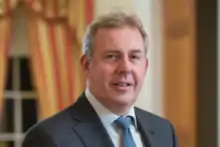 Kim Darroch, Diplomat, former Ambassador to the United States
Kim Darroch, Diplomat, former Ambassador to the United States.jpg.webp)
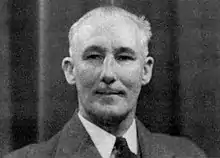 Tracy Philipps, Intelligence Officer, Arab Bureau member, and Conservationist
Tracy Philipps, Intelligence Officer, Arab Bureau member, and Conservationist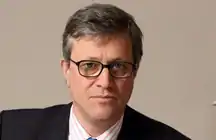 Bruce Bucknell, Diplomat, currently Deputy High Commissioner in India
Bruce Bucknell, Diplomat, currently Deputy High Commissioner in India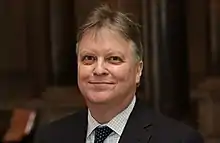 David Fitton, Diplomat, former High Commissioner to Jamaica
David Fitton, Diplomat, former High Commissioner to Jamaica
Hatfielders in the military include Lord Dannatt, a former Chief of the General Staff, and one of his successors in the same role – General Mark Carleton-Smith.[112][113] The late Air Marshall Peter Walker, Rear Admiral Andrew Burns and retired Rear Admiral Matthew Parr were also Hatfield undergraduates, in addition to Major-General Peter Grant Peterkin, who would go on to be appointed Serjeant at Arms in the House of Commons.[114][115][116][117] Michael Warrender, the 3rd Baron Bruntisfield, was a Major in the Irish Guards before embarking on a business career.[118] Tracy Philipps, once a soldier amid numerous other activities in an action-packed life, won the Military Cross during the First World War for his endeavours in the East African Campaign.[119]
At least 5 alumni have held ambassadorial level posts in the Foreign Office. They include: Kim Darroch, previously British Ambassador to the United States; former High Commissioner to Jamaica David Fitton; former High Commissioner to Bangladesh David Carter; Bruce Bucknell, a former British Ambassador to Belarus; and William Quantrill, who served as Ambassador to Cameroon.[120][121][122][123] Peter Waterworth, an ex-Senior Man, was Governor of Montserrat from 2007 to 2011.[124]
_%2540_the_Senedd.jpg.webp) Jeremy Vine, presenter, broadcaster and journalist for the BBC
Jeremy Vine, presenter, broadcaster and journalist for the BBC.jpg.webp) Tim Smit, founder of the Eden Project
Tim Smit, founder of the Eden Project.jpg.webp) Ed Gamble, comedian known for appearing on Mock the Week
Ed Gamble, comedian known for appearing on Mock the Week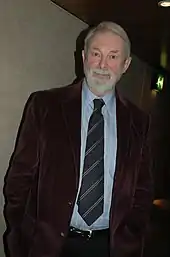 Colin McDowell, former Fashion Editor of The Sunday Times
Colin McDowell, former Fashion Editor of The Sunday Times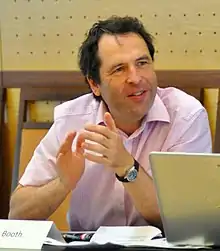 Philip Booth, Senior Academic Fellow at the Institute of Economic Affairs
Philip Booth, Senior Academic Fellow at the Institute of Economic Affairs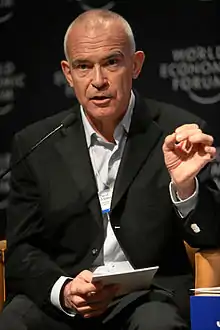 David Arkless, pictured here at World Economic Forum annual meeting
David Arkless, pictured here at World Economic Forum annual meeting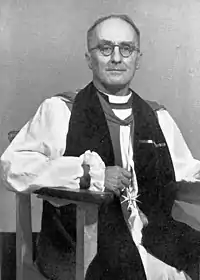 Morris Gelsthorpe, missionary and Anglican Bishop
Morris Gelsthorpe, missionary and Anglican Bishop
In the media there are names such as broadcaster Jeremy Vine, presenters Mark Durden-Smith and Jonathan Gould, and Science Editor of BBC News David Shukman.[125][126][127] Travel writer Alexander Frater was a Hatfield student, as was the poet and memoirist Thomas Blackburn, the fashion journalist Colin McDowell, singer-songwriter Jake Thackray, and comedian Ed Gamble.[128][129][130][125][131] Elsewhere, the landowner Delaval Astley, the 23rd Baron Hastings, has dabbled in acting, playing Cameron Fraser in The Archers for a number of years.[132] Ecclesiastical alumni are numerous: with former Bishop of Derby Peter Dawes, Clive Handford, Francis ffolkes, 5th Baronet, and Morris Gelsthorpe, the first Bishop in the Sudan, making up just a small sample.[133][134][135][136]
In academia, the particle physicist Nigel Glover, the glaciologist David Vaughan, the classicist R. M. Errington, economist Philip Booth, the botanist Stan Woodell and British Antarctic Survey geologist Joanne Johnson were all students at the college.[137][138][139][140] The late sociologist Ian Taylor combined his studies with campaigning against Apartheid while a Hatfield undergraduate.[141] Fund manager Richard Pease, Eden Project founder Tim Smit, BP executive Richard Paniguian, telecoms entrepreneur Peter Owen Edmunds, and David Arkless, once head of CDI Corporation and now Chairman of End Human Trafficking Now, are all examples of alumni from the business world.[142][143][144][145][146]
See also
- List of Hatfield College alumni with articles on Wikipedia
- History of Durham University
- Hatfield Trust
- Hatfield Alumni Association
Notes
- 8 former students are featured in the Oxford Dictionary of National Biography. They are, in order of surname, Kingsley Dunham, Alastair Haggart, Harold Orton, Frederick William Sanderson, Jake Thackray, Percy Warrington, Adrian Woodruffe-Peacock, and Ted Wragg[91][92][93][94][95][96][97][98]
References
Bibliography
- Dimbleby, Josceline (2004). A Profound Secret : Mary Gaskell, her daughter Amy and Edward Burne-Jones. London: Transworld Publishers. pp. 33–35. ISBN 9780552999816.
- Moyes, Arthur (2007). Be The Best You Can Be: A History of Sport at Hatfield College, Durham University. Durham: Hatfield College Trust. OCLC 912903369.
- Moyes, Arthur (1996). Hatfield 1846–1996 : A History of Hatfield College in the University of Durham. Durham: Hatfield College Trust. ISBN 0903324016.
- Whitworth, Thomas (1971). Yellow Sandstone and Mellow Brick: An Account of Hatfield College, Durham, 1846-1971. Durham: Hatfield College, Durham. ISBN 9780903324007.
Citations
- "Term-Time Accommodation Stats" (PDF). Student Registry. Retrieved 30 March 2018.
- Dimbleby, Josceline (2004). A Profound Secret : Mary Gaskell, her daughter Amy and Edward Burne-Jones. London: Transworld Publishers. pp. 33–35. ISBN 9780552999816.
- "Celebrating 30 Years of Hatfield Women". Hatfield College, Durham. Retrieved 23 October 2019.
- Gaspar, Clara. "Hatfield College reveals newly refurbished bar and facilities". Palatinate. Retrieved 6 November 2018.
- "Hatfield College : Who's Who – Durham University". Durham University. Retrieved 7 March 2018.
- "Hatfield College History: Introduction". Retrieved 2 March 2018.
- "Hatfield College History". Durham University Community. Retrieved 6 March 2018.
- Moyes, Arthur (1996). Hatfield 1846 – 1996: A History of Hatfield College in the University of Durham. Durham: Hatfield College Trust. pp. 57–59. ISBN 0903324016.
- "College History Summary" (PDF). Hatfield College. Retrieved 4 March 2018.
- Moyes, 1996, p. 93
- Moyes, p. 93
- Whitworth, Thomas (1971). Yellow Sandstone and Mellow Brick. Durham: Hatfield College, Durham. p. 28. ISBN 9780903324007.
- Whitworth, p. 33
- p. 33
- Whitworth, p. 34
- Moyes, 1996, pp. 149–151
- Moyes, p. 163
- Moyes, p. 166
- Moyes, pp. 173–174
- Moyes, p. 195
- "Buildings". Hatfield College History. Retrieved 28 September 2019.
- Whitworth, p. 46
- Whitworth, p. 47
- Whitworth, p. 51
- "Background to the Hatfield Affair". Palatinate (182). 23 May 1964. Retrieved 9 September 2018.
- Whitworth, p.53
- Moyes, 1996, p. 324
- "oh Hatfield..." Palatinate (379): 8. 10 October 1984. Retrieved 10 September 2018.
- "Hatfield All Mixed Up". Palatinate (385): 8. 14 February 1985. Retrieved 12 September 2018.
- "Hatfield For Girls". Palatinate (388): 388. 9 May 1985. Retrieved 12 September 2018.
- Moyes, 1996, p.306
- "Hatfield College". Durham World Heritage Site. Retrieved 13 September 2018.
- "Hatfield Record – 2009". Issuu. Retrieved 13 September 2018.
- "Location & Buildings". Hatfield College, Durham. Retrieved 28 September 2019.
- Whitworth, p. 44
- O'Hara, Robert James (24 May 2005). "Hatfield College (Re)Dedicates its Melville Building". Collegiate Way. Retrieved 28 September 2019.
- "Building renamed in founder's honour". The Northern Echo. 7 May 2005. Retrieved 28 September 2019.
- "Hatfield College History: Buildings". Retrieved 2 March 2018.
- Whitworth, p. 49
- Moyes, Arthur (2011). The History of the Hatfield Association. Durham: Hatfield College Trust. p. 57.
- Whitworth, p. 50
- "Social spaces". Hatfield College, Durham. Retrieved 28 September 2019.
- "Hatfield Chapel Choir". Music Durham. Retrieved 20 March 2020.
- Woodward, John (1894). A Treatise on Ecclesiastical Heraldry. W. & A.K. Johnston. p. 444. ISBN 9785878640695.
- "Hatfield College : Crest & Motto". Durham University. Retrieved 13 September 2018.
- "Hatfield College – Durham University". Durham University.
- "History of Hatfield" (PDF).
- "Hatfield College (Durham University)". Heraldry of the World. Retrieved 28 February 2019.
- "Term-Time Accommodation Stats" (PDF). Student Registry. Retrieved 30 March 2018.
- "Hatfield College @ Durham SU". Durham Student Union. Retrieved 27 March 2018.
- "The Executive Committee". Hatfield College JCR (via Internet Wayback Machine). Archived from the original on 6 November 2012. Retrieved 20 March 2020.
- "Hatfield JCR crush motion to rename Senior Man". Durham University. 15 May 2014. Retrieved 15 March 2018.
- "Hatfield College JCR rejects motion to change JCR President title to 'Senior Student'". Palatinate. 24 January 2016. Retrieved 15 March 2018.
- "James Barber House". Hatfield College MCR. Retrieved 13 September 2018.
- "Hatfield SCR". Durham University. Retrieved 20 March 2020.
- "College Preference – Total Applications" (PDF). Student Registry. Retrieved 27 March 2018.
- "College Entrants – Total Entrants" (PDF). Student Registry. Retrieved 27 March 2018.
- "College Preference – Total Applications (2014–2015)" (PDF). Student Registry. Retrieved 27 March 2018.
- "College Preference – Total Applications (2013–2014)" (PDF). Student Registry. Retrieved 27 March 2018.
- "College Preference Statistics" (PDF). Durham University Collegiate Office. Retrieved 30 March 2018.
- "These are officially the most private school Durham colleges". The Tab Durham. 28 February 2018. Retrieved 27 March 2018.
- "The Palatine Jungle: Part 1". Durham21. Retrieved 27 March 2018.
- "Durham's worst colleges". The Tab Durham. 7 November 2014. Retrieved 27 March 2018.
- Bennett, Clare (2 October 2012). "Surviving freshers: The Tatler Guide to the Durham University". Tatler. Retrieved 6 June 2020.
- Bash, Anthony (2019). "Notes from the Vice-Master and Senior Tutor". Hatfield Record 2019. Hatfield College Trust: 11. Retrieved 6 June 2020.
- "College Preference by School Type (2015–2016)" (PDF). Student Registry. Retrieved 27 March 2018.
- "College Preference by School Type (2014–2015)" (PDF). Student Registry. Retrieved 27 March 2018.
- "Oxbridge Admissions" (PDF). Sutton Trust. Retrieved 12 November 2020.
- "Jevons, Frank Byron, (9 September 1858 – 29 February 1936)". Who Was Who. Oxford University Press. 1 December 2007. Retrieved 13 September 2018.
- "Robinson, Arthur, (10 March 1864 – 21 March 1948)". Who Was Who. Oxford University Press. 1 December 2007. Retrieved 13 September 2018.
- "Macfarlane-Grieve, Angus Alexander, (11 May 1891 – 2 August 1970)". Who Was Who. Oxford University Press. 1 December 2007. Retrieved 13 September 2018.
- "Birley, Prof. Eric, (12 January 1906 – 20 October 1995)". Who Was Who. Oxford University Press. 1 December 2007. Retrieved 13 September 2018.
- "Whitworth, Thomas, (7 April 1917 – 18 December 1979)". Who Was Who. Oxford University Press. 1 December 2007. Retrieved 13 September 2018.
- "Barber, Prof. James Peden, (6 November 1931 – 24 July 2015)". Who Was Who. Oxford University Press. 1 December 2007. Retrieved 13 September 2018.
- "Goodbye Garden Party for Professor Tim Burt, Master of Hatfield College". Durham University. 16 June 2017.
- "Hatfield Record 2012" (PDF). Hatfield Association. Retrieved 26 March 2018.
- "Hatfield College : Junior Research Fellows". Durham University. Retrieved 29 March 2018.
- "Senior Research Fellows". Durham University. Retrieved 26 August 2019.
- "IAS Fellows". Institute of Advanced Study. Retrieved 26 March 2018.
- "Finding the Balance". Hatfield JCR. Retrieved 21 April 2018.
- "Hatfield Hall Boat Club". Durham University Journal. Durham. 4: 91. 26 March 1881. Retrieved 30 March 2020.
- Martin, Susan (2006). "10: Into the Future". Trevs: A Celebration of 40 Years. Roundtuit Publishing. p. 194.
- White, Charles; Capel, Charlie (16 May 2016). "Nazi Graffiti targets Durham student homes and boathouses". The Durham Tab. Retrieved 30 March 2020.
- Kirk, Adam (2019). "Boat Club". Hatfield Record: 83. Retrieved 30 March 2020.
- Whitworth, p. 85
- Unwin, Bruce (18 September 2019). "Durham University 1969 team for reunion". The Northern Echo. Retrieved 30 March 2020.
- Beech, Emily (12 November 2013). "Hild Bede and Hatfield rugby stronger than ever". Palatinate. Retrieved 30 March 2020.
- Morgan, Charlie (7 June 2019). "Josh Basham interview: Durham University and Newcastle Falcons back-rower poised for return as England U20 aim to bounce back". The Telegraph. Retrieved 11 June 2019.
- "Home". Hatfield SHAPED.
- "Hatfield Association". Durham University. Retrieved 13 September 2018.
- Peter A. Sabine (6 January 2005). "Dunham, Sir Kingsley Charles (1910–2001)". Oxford Dictionary of National Biography. Oxford University Press. Retrieved 28 October 2020.
- Edward Luscombe (23 September 2004). "Haggart, Alastair Iain Macdonald (1915–1998)". Oxford Dictionary of National Biography. Oxford University Press. Retrieved 28 October 2020.
- Stanley Ellis (8 October 2009). "Orton, Harold (1898–1975)". Oxford Dictionary of National Biography. Oxford University Press. Retrieved 28 October 2020.
- M. C. Curthoys (23 September 2004). "Sanderson, Frederick William (1857–1922)". Oxford Dictionary of National Biography. Oxford University Press. Retrieved 28 October 2020.
- Robb Johnson (5 January 2006). "Thackray, John Philip [Jake] (1938–2002)". Oxford Dictionary of National Biography. Oxford University Press. Retrieved 28 October 2020.
- B. J. W. Turnock (23 September 2004). "Warrington, Percy Ewart (1889–1961)". Oxford Dictionary of National Biography. Oxford University Press. Retrieved 28 October 2020.
- Mark Seaward (23 September 2004). "Peacock, (Edward) Adrian Woodruffe- (1858–1922)". Oxford Dictionary of National Biography. Oxford University Press. Retrieved 28 October 2020.
- Wendy Berliner (8 January 2009). "Wragg, Edward Conrad [Ted] (1938–2005)". Oxford Dictionary of National Biography. Oxford University Press. Retrieved 28 October 2020.
- Widdison, Penny (2 March 2009). "Sporting Greats". Hatfield History (via Internet Wayback Machine). Archived from the original on 2 March 2009. Retrieved 26 August 2019.
- "Allowing exceptional people to do exceptional things". Durham University. Retrieved 13 September 2018.
- "Durham alumni Andrew Strauss named England Test and One Day Cricket captain". BUCS (via Internet Wayback Machine). 12 January 2009. Archived from the original on 3 August 2009. Retrieved 20 March 2020.
- Friend, Nick. "Opening up: Nick Compton on pressure, England, Pietersen and more". Palatinate. Retrieved 9 November 2018.
- "Tim Curtis". Cricinfo. Retrieved 25 March 2019.
- Team, Records (12 August 2017). "Katie Ford Indoor Track records". World UltraCycling Association. Retrieved 7 May 2019.
- "Members of Parliament for Swindon". Newsquest Media Group. Retrieved 12 March 2011.
- "Hello from Edward Timpson". Eddisbury Conservatives. Retrieved 20 December 2019.
- "Edward Timpson". Crewe Chronicle. Retrieved 7 March 2019.
- "Carter of Coles, Baron, (Patrick Robert Carter) (born 9 Feb. 1946)". Who's Who. Oxford University Press. 1 December 2007. Retrieved 13 September 2018.
- "Scholarships, Exhibitions". Durham University Journal. 10 (1–18): 212. 4 November 1893.
- Fyle, Magbaily (2006). Historical Dictionary of Sierra Leone. Metuchen, New Jersey: Scarecrow Press. p. 57.
- Moyes, 1996, p. 315
- Lishman, James (9 November 2011). "General Lord Dannatt: A Short Profile". The Bubble. Retrieved 7 March 2019.
- Allison, George (9 May 2018). "Mark Carleton-Smith appointed new Chief of the General Staff". UK Defence Journal. Retrieved 7 March 2019.
- "Hatfield Record 2016". 2016. pp. 192–193. Retrieved 7 March 2019.
- "Members' News" (PDF). Hatfield Record: 177. 2017. Retrieved 11 June 2019.
- "New Year Honours 2014". Dunelm (1): 10. 2015. Retrieved 20 March 2020.
- "Gazette". Durham University. 1971. Retrieved 7 March 2019.
- "Results of Final Examinations held in June 1972". Durham University Gazette. 19: 6. 1972. Retrieved 18 March 2020.
- "Calendar 1912–13". Durham University Archive. Retrieved 12 March 2018.
- "Darroch, Sir (Nigel) Kim". Who's Who. Oxford University Press. 1 December 2007. Retrieved 21 March 2020.
- "Congregations at Durham". Durham University Gazette. 23: 56. 1978. Retrieved 20 March 2020.
- "December Congregation". Durham University Gazette. 24: 74. 1979. Retrieved 20 March 2020.
- "Results of Final Examinations June 1984". Durham University Gazette 1983/84. 2: 94. 1984. Retrieved 20 March 2020.
- "Results of Final Examinations held in June 1978". Durham University Gazette. 24: 58. 1979. Retrieved 20 March 2020.
- List of alumni, URL accessed 18 May 2009
- "Hatfield College : Alumni – Durham University". Durham University (via Internet Wayback Machine). 16 June 2006. Archived from the original on 16 June 2006. Retrieved 30 April 2018.
- "Final Examination For The Degree Of B.A. With Honours". Durham University Gazette. 25: 50. 1981. Retrieved 21 March 2020.
- Moyes, Arthur (2007). Be The Best You Can Be: A History of Sport at Hatfield College, Durham University. Hatfield College Trust. p. 80.
- "Thomas Blackburn Special Collections". Leeds University Library. Retrieved 1 May 2018.
- "Editorial". Palatinate (99): 2. 22 February 1957. Retrieved 11 September 2018.
- "Ed Gamble: From Hatfield to Hammersmith Apollo". Palatinate Online. 7 March 2019. Retrieved 12 March 2019.
- "Durham Dramsocs 1979". Palatinate (318): 8. 25 January 1979. Retrieved 11 December 2019.
- "Dawes, Rt Rev. Peter Spencer". Who's Who. Oxford University Press. 1 December 2007. Retrieved 18 March 2020.
- "Graduates". University of Durham Gazette: 9. September 1961.
- "Degrees and Licences Conferred in 1885". Durham University Calendar: 144. 1887. Retrieved 18 March 2020.
- "Matriculation Examination". Durham University Calendar 1912–13: 334. 1913. Retrieved 16 December 2019.
- "Profile". LinkedIn. Retrieved 15 March 2018.
- "Vaughan, Dr David Glyn". UK Who's Who. Retrieved 30 November 2018.
- Moyes, 1996, p. 260
- "Joanne Johnson". British Antarctic Survey. Retrieved 7 March 2019.
- "Letters to the Editor". Palatinate (190): 2. 12 February 1965.
- "Final Examination For The Degree Of B.A. In General Studies". Durham University Gazette. 25: 39. 1981. Retrieved 20 March 2020.
- "Sixth Congregation". Durham University Gazette. 22: 52. 1977. Retrieved 20 March 2020.
- "Report by the Vice-chancellor and Warden for the year 1970–71". Durham University Archives. p. 136. Retrieved 11 September 2019.
- "Results of Final Examinations held in June 1981". Durham University Gazette. 26: 58. 1982. Retrieved 3 March 2020.
- "Final Examinations For The Degree of B.A. In General Studies". Durham University Gazette. 22: 34. 1977. Retrieved 20 March 2020.
External links
| Wikimedia Commons has media related to Hatfield College, Durham. |
